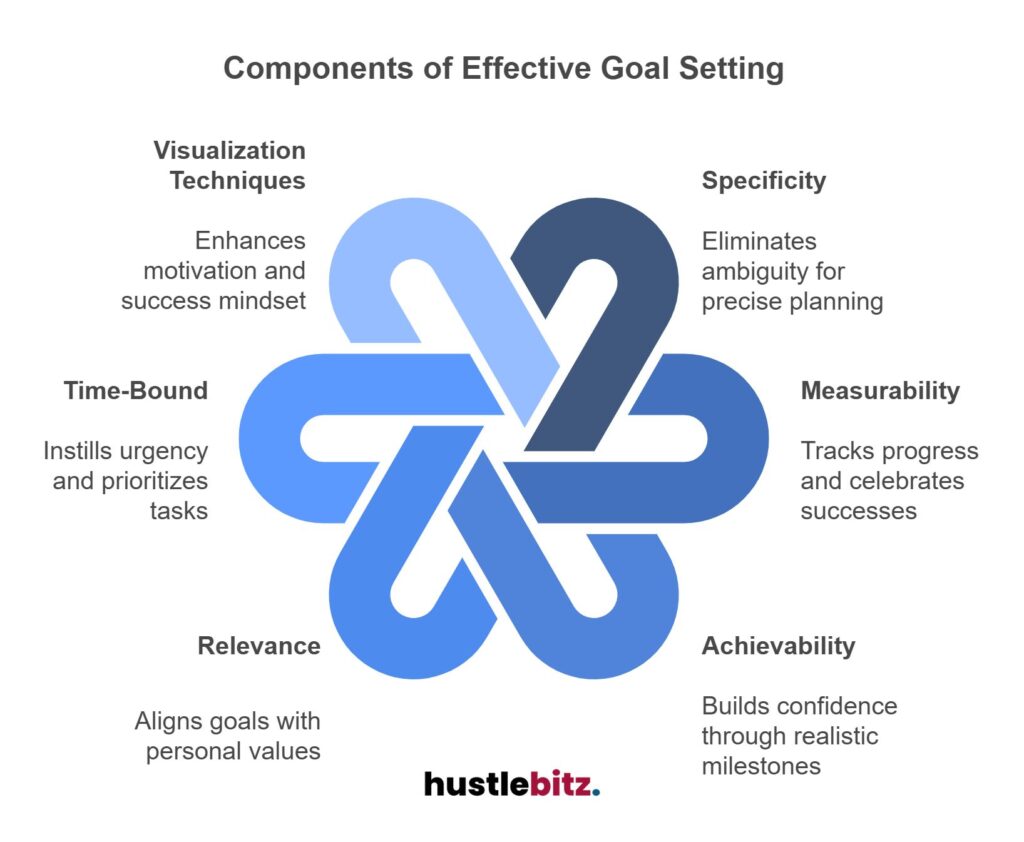Achieving success with SMART goals is an effective strategy for personal and professional growth. By ensuring your goals are Specific, Measurable, Achievable, Relevant, and Time-bound, you create a clear roadmap for progress. Specificity eliminates ambiguity, while achievable milestones build confidence. Keeping your goals aligned with personal aspirations enhances motivation and purpose. Additionally, incorporating time-bound targets instills a sense of urgency, promoting consistent advancement. Visualization techniques further reinforce commitment by allowing you to envision success. Embracing challenges as opportunities fosters resilience. To sustain momentum, celebrating small wins is vital. Exploring these elements can enhance your journey toward meaningful achievements.
Key Takeaways
- SMART goals provide a structured framework for setting clear, actionable objectives that enhance personal growth and accountability.
- Specificity in goal setting eliminates ambiguity, allowing for precise planning and alignment with personal values.
- Achievable goals build confidence and motivation through realistic milestones that track progress and celebrate small successes.
- Time-bound targets instill urgency, creating accountability and helping prioritize impactful tasks for consistent progress.
- Visualization techniques, such as creative imagery and positive affirmations, enhance motivation and foster a success-oriented mindset.

SMART Goals Are the Key to Unlocking Your Potential

SMART goals serve as a strategic framework that empowers individuals to transform their aspirations into achievable milestones, ultimately unlocking their full potential. By employing this structured approach to goal setting, individuals can significantly enhance their personal growth journey. The SMART criteria—Specific, Measurable, Achievable, Relevant, and Time-bound—serve as a foundation for effective motivation strategies, ensuring that each goal is clear and attainable.
Incorporating self-discipline into the SMART goal framework fosters resilience building, enabling individuals to navigate challenges and remain steadfast in their pursuits. The integration of accountability partners can further amplify commitment, providing support and encouragement while also holding individuals responsible for their progress. Utilizing tools such as vision boards can visually reinforce these goals, creating a constant reminder of one’s objectives and aspirations.
Moreover, performance tracking is essential in evaluating progress towards long-term success. Regular assessments allow for necessary adjustments, fostering a growth mindset that embraces flexibility and learning. As individuals experience mindset shifts, they become more adept at overcoming obstacles, thereby reinforcing their resilience.
Ultimately, SMART goals not only delineate a clear path toward success but also cultivate essential skills and attributes necessary for achieving one’s dreams. By systematically approaching goal setting, individuals are better equipped to unlock their potential, ensuring that their aspirations evolve into tangible accomplishments.
This holistic approach not only enhances personal growth but also lays the groundwork for sustained achievement in various facets of life.
The Importance of Specificity: The First Step Toward Success

Specificity in goal setting serves as a foundational element that transforms vague aspirations into clear, actionable objectives, paving the way for measurable success. By defining specific outcomes, individuals create a framework that fosters focused direction and motivates consistent effort. Clear intentions eliminate ambiguity, allowing for precise planning that outlines exactly what needs to be accomplished.
To achieve success, it is essential to establish tailored objectives that resonate with personal values and aspirations. These objectives, when articulated with specificity, facilitate the identification of measurable actions necessary for progress. For instance, instead of stating a desire to ‘get fit,’ one might specify a goal to ’exercise for 30 minutes, five times a week.’ This concrete example illustrates how specificity leads to defined parameters that guide behavior.
Establishing targeted milestones is another critical aspect of specificity. These milestones act as checkpoints, providing understandable metrics to assess progress. By breaking down larger goals into smaller, manageable tasks, individuals can celebrate incremental achievements, thus maintaining motivation.
Achievable Goals: Building Confidence with Each Milestone
Setting achievable goals is crucial for fostering self-confidence and maintaining motivation throughout the journey toward success. When individuals set realistic objectives, they embark on a structured path that encourages personal growth and skill development. By focusing on incremental progress, goal setting becomes a powerful tool for confidence building. Each milestone achieved serves as a testament to one’s capabilities, reinforcing an achievement mindset.
Milestone tracking is essential in this process, as it allows for self-assessment and reflection on one’s progress. By breaking larger goals into smaller, manageable tasks, individuals can celebrate their successes, which acts as positive reinforcement. This approach not only fuels motivation but also cultivates resilience training, preparing individuals to face challenges head-on.
Here’s a simple framework for tracking achievable goals:
| Milestone | Action Steps | Completion Date |
| Define a specific skill | Research and plan | [Insert Date] |
| Complete a relevant course | Enroll and engage | [Insert Date] |
| Apply knowledge in practice | Seek opportunities | [Insert Date] |
Staying Relevant: Aligning Your Goals with Your Dreams

Regularly aligning your goals with your dreams is essential for maintaining motivation and ensuring that your efforts are directed toward meaningful outcomes. This process, known as dream alignment, enables individuals to achieve goal clarity and maintain vision consistency.
By focusing on what truly matters, you can better engage in passion pursuit while ensuring that your actions resonate with your core values.
To effectively integrate your dreams and goals, consider the following strategies:
- Purpose Identification: Clearly define what drives you and why your dreams matter.
- Aspiration Mapping: Break down your long-term dreams into actionable goals that can be accomplished in the short term.
- Intention Setting: Establish clear intentions that guide your actions and decisions toward your aspirations.
- Future Planning: Regularly review and adjust your goals to ensure they remain aligned with your evolving dreams.
This alignment fosters motivation sources that are intrinsically tied to your values, creating a compelling reason to pursue your objectives. By integrating values into your goal-setting process, you reinforce a sense of purpose and direction, enabling you to navigate obstacles with resilience.
Ultimately, staying relevant in your goal-setting journey involves a continuous commitment to refining your aspirations and ensuring they reflect your true self. This dedication not only enhances your overall satisfaction but also propels you toward sustainable success.
Embrace the journey of dream alignment, and you will find fulfillment in both your goals and your life.
Time-Bound Targets: Creating a Sense of Urgency and Focus

Establishing time-bound targets not only enhances the alignment of your goals with your dreams but also instills a sense of urgency and focus that drives you toward their achievement. By incorporating deadlines into your goal-setting process, you create a framework that fosters accountability and encourages consistent progress tracking. This deadline pressure acts as a catalyst, compelling you to take action rather than procrastinate.
To maximize the effectiveness of your time-bound targets, consider employing urgency tactics such as breaking down larger goals into smaller, manageable tasks with their own deadlines. This not only makes the process less daunting but also allows for effective time allocation. Focus techniques, such as the Pomodoro Technique, can boost your productivity by promoting intense work sessions followed by brief breaks, ensuring sustained concentration.
Incorporating prioritization methods is essential for effective time management. Identify which tasks will drive you closer to your goals and tackle them first. Additionally, collaborating with accountability partners can enhance your commitment to meeting deadlines, as sharing your goals increases the likelihood of follow-through.
Productivity hacks, such as using digital tools for reminders and progress tracking, can streamline your efforts. By keeping your targets visible and regularly updating your progress, you maintain motivation.
The Power of Visualization: Seeing Your Success Before It Happens
Harnessing the power of visualization can significantly enhance your motivation and clarity as you work towards achieving your goals. By employing effective visualization techniques, you can create a strong mental image of your desired outcomes, allowing you to align your actions with your aspirations. This practice fosters a success mindset that is essential for goal manifestation.
Engaging in visualization exercises not only strengthens your belief systems but also helps establish emotional resonance with your future self. When you vividly imagine the success you seek, your brain begins to accept this vision as reality, thereby motivating you to take actionable steps.
To maximize the effectiveness of your visualization practice, consider incorporating the following elements:
- Creative Visualization: Use detailed imagery to paint a picture of your success, including sights, sounds, and feelings.
- Positive Affirmations: Reinforce your visualizations with affirmations that support your goals, enhancing your self-belief.
- Consistent Practice: Make visualization a regular part of your routine to solidify your vision and maintain focus.
- Emotionally Charged Imagery: Include emotions in your visualizations to create a deeper connection to your future self and desired outcomes.
Overcoming Obstacles: Turning Challenges into Opportunities

Overcoming obstacles requires a resilient mindset that views challenges as opportunities for growth and development. This approach not only fosters a growth mindset but also encourages effective resilience strategies. By embracing mindset shifts, individuals can transform setbacks into valuable learning experiences, enabling them to identify proactive solutions that drive progress.
Resourcefulness skills play a critical role in navigating obstacles. When faced with adversity, leveraging adaptability techniques allows individuals to pivot and adjust their strategies. This adaptability is essential in risk management, as it equips one to anticipate potential issues and develop contingency plans. Emotional intelligence further enhances this process by enabling individuals to recognize and regulate their emotions, fostering a balanced response to challenges.
Support networks are vital in overcoming obstacles. Engaging with mentors, peers, or professional groups can provide guidance and encouragement, reinforcing a sense of community and shared experience. These networks can offer insights and alternative perspectives, enriching one’s approach to problem-solving.
Ultimately, the ability to turn challenges into opportunities requires a commitment to personal growth and continuous learning. By cultivating a mindset that embraces adversity, individuals can develop not only their resilience but also their overall capacity for success.
Embracing these principles ensures that obstacles become stepping stones on the path to achieving SMART goals, paving the way for sustained achievement and fulfillment.
Celebrating Small Wins: Fueling Motivation for Bigger Achievements

Recognizing and celebrating small wins plays a crucial role in maintaining motivation and momentum toward achieving larger goals. Acknowledging these small victories not only fosters a sense of accomplishment but also provides a significant motivation boost, reinforcing the journey toward more substantial achievements. It cultivates a positive environment where individuals feel valued and encouraged to continue striving for their goals.
To effectively celebrate progress, consider implementing the following strategies:
- Establish Reward Systems: Create personal milestones that come with tangible rewards, reinforcing the importance of each achievement.
- Practice Gratitude: Regularly reflect on what you have accomplished and express gratitude for the support received along the way.
- Encourage Team Support: Foster a culture where team members recognize each other’s achievements, creating a collaborative atmosphere that enhances motivation.
- Engage in Goal Reflection: Take time to review your progress, recognizing achievements that may seem minor but contribute significantly to your overall objectives.
Final Thoughts
Achieving success with SMART goals is about more than just setting objectives; it’s about creating a clear, actionable plan that aligns with your values and aspirations. By focusing on specificity, setting achievable targets, and maintaining relevance, you can build a strong foundation for personal and professional growth. Incorporating time-bound targets and visualization techniques further enhances your motivation, while turning challenges into opportunities fosters resilience. Celebrating small wins along the way keeps you motivated and reinforces your commitment to long-term success. By embracing this strategic approach, you pave the way for meaningful and sustained achievements in all areas of your life.




